#each of their numbers are the other's but reversed. also nine was a classical composer in life and there's a superstition that classical
Explore tagged Tumblr posts
Text
my naming scheme for the resurrectionists causes me undue stress a lot of the time but when it works it Works
#edgar mortis is obv edgar allen poe + latin word for death. and his surname plays off the fact that there are four other resurrection men#only identified by their surnames which are pallor livor rigor and algor. rigor mortis should be easy to clock but the rest are all stages#of death as well when you attach -mortis to the end of them. which cements edgar's identity as a resurrection man even when he's farrr too#consumed by morana's world of magic and mystery to be actively working.#morana faust is a slavic death goddess + faust. the most famous necromancer in all of fiction. once again her surname cements her identity#as a necromancer specifically even when she gets swept away by unrelated magical happenings#nine and shi aren't their real names but their identification numbers are 9444999 and 4999444. 9 and 4 are both associated with death and#each of their numbers are the other's but reversed. also nine was a classical composer in life and there's a superstition that classical#composers will not live to write their 9th symphony (he sure as hell didn't lol) so it's fitting that he's the one who ended up with the#nickname. abberline isn't his real name either so he doesn't count. valdís has ancient norse for 'death' (val) + 'dis' (goddess) despite th#name not actually being used for any actual death goddess and her surname toth is likely derived from a medieval german word for death#her name isn't glaringly out of place with the rest of the cast but doesn't immediately let you catch on to her whole deal#which is good bc valdís is meant to sort of blend into the backround of reader's minds until The Reveal.#mara is a minor hindu goddess of death and her surname grave is. well. self explanatory. i tried to give the more non-magical side of londo#more straightforward names to contrast with some of the others and obv her dad was created before her and dr grave seemed like a good name#for someone who only popped up in the story while he was hiring professional grave robbers (now he pawns that task off on mara lol)#ereshkigal kore is just queen of the underworld + queen of the underworld but def has a very grandiose feel which is good bc that's#absolutely the vibes she should be giving off. all her servants' names boil down to figures associated with the greek + mesopotamian#underworlds. mainly attendants of aforementioned goddesses. which fits bc they all serve her#but i'd like to give special consideration to the maid trio here bc they're a set of triplets. and their last name is cerberus.#which famously had 3 heads. and the older two feature a similar naming scheme as persephone + eurydice (they even both end in the same e#sound) but the youngest's name is aisha which means 'living' or 'alive'. and obv her departure from the naming scheme makes her more easily#differentiated from her sisters + more memorable in the long run which is good bc she's the most important maid but it also gives me room t#have a 'my name means alive but she's named for the queen of the underworld so i'm willing to not live up to my name if it means being#closer to her' moment w a shitton of lilies in frame in case it isn't clear to anyone what's going on ('her' means eresh not persephone btw#and then there's dysmas. the patron saint of undertakers. which fits bc catholic. and sanson. as in the executioner. for a character heavil#inspired by the nasuverse's church executioners like kirei and ciel#rosette comes from the rosette nebula which looks like a skull. hayden is from one of my kids at work who said that next time i wrote a#murderer into something i had to name them after her so. here you go hayden. you get to be the cannibalistic child. (the topic came up when#i had to make a murder mystery for class so i stole the names from my kids and i told the ones whose names i used abt it later and she was
3 notes
·
View notes
Text
essay update~!
inching ever closer to the right word and page count!! mobile users, i apologize if the read more function doesn’t work bc this one is a doozy
as always, PLEASE don’t hesitate to read and critique, bc i need that sweet sweet criticism babey
Few franchises can match the breadth of Star Wars, and fewer still can claim to be as iconic. Not only have the characters, dialogues, settings, and aesthetics been directly referenced and lovingly parodied across all genres, so too has John Williams’ music. Yet Williams’ music is perhaps most referenced, riffed on, and remixed within the franchise itself; it is difficult to find a piece of Star Wars media which does not contain any number of Williams’ leitmotifs, such as the bombastic “Main Title” fanfare, the sweeping majesty of the Force theme, or the foreboding, villainous “Imperial March.” Within the many, many Star Wars related properties that require the use of music, composers for the franchise’s “lower tier” [properties], i.e. any property outside of the nine-film “Skywalker Saga,” are presented with a difficult challenge: how does one emulate and reference Williams’ original, titanic score, keeping a coherent sonic aesthetic, without copying him directly, and allowing space for the composer’s own musical language?
By the 1950s and 60s, the practice of using Romantic music to accompany films was dying out; music by composers such as Max Steiner, Erich Korngold, or Leonard Bernstein was slowly being replaced by popular music of the era, or, as was the case with many science fiction films, electro-acoustic music. For example, Bernard Hermann in The Day the Earth Stood Still (dir. Robert Wise, 1951) used electronic instruments for the bulk of his orchestra, along with innovative techniques in overdubbing and tape-reversal. Five years later, Bebe Barron, alongside husband Louis Barron, would write one of the first entirely electronic scores for Forbidden Planet (dir. Fred Wilcox, 1956). Outside the realm of science fiction, films such as Breakfast at Tiffany’s (dir. Blake Edwards, 1961) or The Graduate (dir. Mike Nichols, 1967) used popular music partly for aesthetic purposes, and partly to exploit the songs’ commercial success outside of the films. Lucas himself elected for the use of a completely pop soundtrack for his film American Graffiti (dir. Lucas, 1973). Stanley Kubrick’s decision to use classical music for 2001: A Space Odyssey (dir. Kubrick, 1960) was unique in film at the time; his use of 19th and 20th century music even more so.
“Traditionally, music for the sci-fi genre would use a language inspired by twentieth-century musical modernism-atonalism, twelve-tone technique, aleatoric music, and so forth-or would use electronic instruments, timbres, or even musique concrete to provide the musical equivalent of futuristic or hyper technological worlds… Stanley Kubrick in [2001: A Space Odyssey] chose to combine images of deep space and unseen worlds with a compilation of repertoire orchestral pieces--after having rudely rejected Alex North’s original score [commissioned specifically for the film]. The selection spanned from classic pieces like Richard Strauss’ Thus Spoke Zarathustra (Also sprach Zarathustra, op. 30, 1896) and Johann Strauss Jr.’s The Blue Danube (An der schonen blauen Donau, op. 314, 1866) to contemporary art music like Gyorgy Ligeti’s Lux Aeterna (1966), Atmospheres (1961), Requiem (1963-65), and Adventures (1962)... Yet Kubrick’s choice was also the consequence of a lack of trust in film composers. ‘However good our best film composers may be, they are not a Beethoven, a Mozart or a Brhams. Why use music which is less good when there is such a multitude of great orchestral music from the past and from our own time?’ Lucas rejected the modernist and electronic options and chose Kubrick’s approach. He wrote the script while listening to the late romantic symphony repertoire…”
Jonathan Rinzler recalls Lucas’ choice of a more traditional, Romantic sonic language as being entirely deliberate, in order to help ease the audience into the extremely unfamiliar fictional world with the use of familiar music. “[Lucas] didn’t want, for example, electronic music, he didn’t want futuristic cliché, outer space noises. He felt that since the picture was so highly different in all of its physical orientations – with the different creatures, places unseen, sights unseen, and noises unheard – that the music should be on fairly familiar emotional ground.”
The larger Star Wars chronology can be broken into three general eras: the Original Trilogy era (OT), which focuses on the time represented by the films A New Hope, Empire Strikes Back, Return of the Jedi, and Rogue One, the Sequel Trilogy era (ST), which is comprised of the films The Force Awakens, The Last Jedi, and The Rise of Skywalker, as well as the TV series Star Wars: Resistance, and the Prequel Trilogy era (PT), as represented by the films The Phantom Menace, Attack of the Clones, Revenge of the Sith, and Solo, as well as the TV series The Clone Wars. Of these properties, Williams has obviously scored the lion’s share of the films; Rogue One’s soundtrack was composed by Michael Giacchino, Resistance by Michael Tavera, Solo by John Powell, and The Clone Wars by Kevin Kiner. Kiner’s other work for Star Wars was the score of another TV series, Star Wars Rebels. Rebels occupies an interesting place within the greater Star Wars chronology, qualifying as a prequel due to taking place before the events of A New Hope, yet both aesthetically and narratively more aligned with the OT, rather than the PT. Though Rebels is nominally a prequel, Kiner’s musical language sets it firmly within the OT era, with frequent sonic callbacks to Williams’ score, with each aesthetic connection serving not only to link the viewer to the OT era, but also, through its absences and deviations, highlight the narrative differences between Rebels and the original films. This is particularly exemplified in the parallels and contrasts between the heroes of Rebels and the OT, Ezra Bridger, and Luke Skywalker.
From the outset, several contrasts and parallels can be drawn between Ezra Bridger and Luke Skywalker: both are orphans from provincial areas of the galaxy, both are accidentally caught up in insurrectionist rebel activity against the Empire, and both discover that they can wield the powers of the Force. They are even roughly the same age, born within days of each other. Contrasts do abound, however. Ezra receives several years of Jedi training from a former Jedi, while Luke receives very little; Ezra is actively involved with the Rebellion from the beginning, while Luke steps in at the last second to secure one of the Alliance’s largest victories; Ezra’s primary motif is connected to the twin moons of his home planet of Lothal - this, in contrast to the famous scene of Luke Skywalker gazing into the twin sunset of his planet of Tatooine; and so on. Even their character designs are oppositional; Luke is quite white, blond-haired and blue-eyed, a country farmer from a family of farmers, kind but naive, whereas Ezra is coded as Jewish or Middle Eastern (his parents’ names are Ephraim and Mira, a name likely derived from Myra, Miriam, or Maryam--this, coupled with his physical features, points to a certain ethnic origin. Mira, in flashbacks, even wears a headscarf, and is one of the few human women in the larger Star Wars universe to do so), with dark hair and darker skin, a homeless city orphan who is more than well-acquainted with the Empire’s atrocities. When it comes to their roles in the Rebellion, though, both Luke and Ezra initially start their adventures with the promise of Jedi training, and find themselves drawn in to the major political and martial action of the Galactic Civil War.
Set five years before the events of A New Hope, the backdrop of Rebels depicts the formal declaration of the Galactic Alliance, the establishment of the famous rebel base on the planet of Yavin IV, and numerous references to the secret construction of the Death Star, alongside several integral character cameos, including Lando Calrissian, Princess Leia, and Obi-wan Kenobi, while the main thrust of the story centers on the crew of the Ghost, an early rebel cell, and the journey of its newest crew member, Ezra Bridger. Described by Dave Filoni, Executive Producer and creator of Rebels, as a con artist, and Taylor Gray, the character’s actor, as “very street smart, he’s a pickpocket, he’s a little thief,” Ezra happens upon the crew of the Ghost as they commit a minor act of terrorism against the Galactic Empire, stealing several crates of supplies. Rather than pick a side in the conflict, Ezra elects to steal a crate of the same supplies for himself, outrunning the comedically incompetent Imperial police force, and dodging the members of the Ghost crew as they try to get the supplies back, until Ezra is forced to seek refuge on the Ghost to escape the marginally more competent TIE figher pilots. After helping the crew in distributing the supplies - namely, food - to a nearby refugee camp, Ezra is convinced by the Ghost’s pilot and leader, Hera Syndulla, to assist in a rescue mission. Despite his initial capture and subsequent escape from Imperial custody, Ezra chooses to see the rescue mission through to the end, and witnesses the Ghost’s second-in-command, Kanan Jarrus, wield a lightsaber, revealing himself as a survivor of the presumed-extinct and quasi-legendary Jedi Order. Recognizing that Ezra has the same gift as him, Kanan offers to train him to wield the Force in order to continue fighting against the Empire, dispelling any notion that the Jedi are gone with a triumphant declaration, “Not all of us.” Ezra agrees, and thus begins their partnership which will last for the next four years, as Kanan, who never technically made it past the rank of apprentice, passes on his fragmented training, and they both become more and more deeply entwined with the Rebellion.
Luke’s introduction to the Rebel Alliance appears to be as coincidental as the above, though one can argue that it was ordained by the Force, or some kind of similar higher power. When his uncle and adoptive father Owen purchases a pair of droids for the farm, Luke discovers a secret message hidden within one of them: Princess Leia’s plea to a mysterious Obi-wan Kenobi for aid. Luke’s first instinct is to help her, seeking out the reclusive loner Ben Kenobi for more information--with the added gratification of disobeying his uncle, who is currently keeping him tied to the family farm, and will not let him leave the planet. When the Empire, inevitably, comes looking for its stolen property--stolen Imperial secrets hidden within one of the droids--Luke is too late to warn his aunt and uncle, and finds his homestead burned to the ground. Grief stricken and alone, Luke begs Obi-wan to take him with him to Alderaan, in order to learn how to be a Jedi like his mysterious father. After hiring smuggler Han Solo to take them to Alderaan, they instead find the Death Star, and Luke convinces Han to mount a daring, ill-planned rescue of the Princess. While they do rescue Leia, they lose Obi-wan as he stalls the Imperials, buying them time to escape. Thoughts of becoming a Jedi are pushed to the background as Luke volunteers to be a part of the attack on the Death Star, despite Han’s insistence that he should take his cut of their reward money and run. Up against an implausible and unbelievable behemoth of a killing machine, a massive weapon capable of genocide on an unimaginable scale, it is Luke and his superhuman abilities which allow him to fire the shot which destroys the Death Star and everybody on it, immediately cementing him as not only a hero, but the hero, from both a Doylist and a Watsonian perspective.
These parallels are further underscored by their respective musical motifs. Consider Luke’s theme, the “Main Title” fanfare. In the words of Williams himself, from the liner notes of the original 1977 LP release:
When I thought of a theme for Luke and his adventures, I composed a melody that reflected the brassy, bold, masculine, and noble qualities I saw in the character. When the theme is played softly, I tended towards a softer brass sound. But I used fanfarish horns for the more heraldic passages. This theme, in particular, brings out the full glow of the glorious brass section of the London Symphony Orchestra.
Comprised primarily of perfect intervals, the theme begins with an ascending fifth, an opening salvo so famous that music students everywhere, yours truly included, use it to identify perfect fifths in other contexts. As Lucas notes, the principal instrumentation is in the brass section, immediately conferring an old-world heroic air to Luke. “[The Main Title theme] conveys the heroism at the heart of the saga with the economy of its opening fifth (reaching upward), descending triplet (gathering strength for another try), and triumphant lift to an octave above the opening note (attainment of the goal).” Peter Nickalls compares this to the “perfect rising fifth” of “Siegfried’s Horn Call” from Wagner’s Ring Cycle as emblematic of many heroic melodies.
[insert sheet music here, recap]
As a theme, it is punchy, energetic, intrinsically tied up in the “Rebel Fanfare,” and generally underscores moments of onscreen heroism and stylistically valiant acts.
By contrast, while Ezra’s theme is also played by the horns, they are muted, thinner, ringing out more softly over shimmering, sustained strings. [insert sheet music here, recap] Ezra’s theme mostly serves to underscore the character’s moments of emotional reflection, rather than his superhuman action, which is usually accompanied by the “Force” theme, the “Rebel Fanfare,” or the Ghost’s musical motif.
Luke’s theme in its first non-diegetic appearance, that is, its first appearance outside of the main titles, is a little different than one would expect; the melody is still a solo, but played in the horns, implicitly sonically identifying Luke as the protagonist, according to Nickalls, and with a much tamer underlying harmonization. Instead of an alternating pattern of quarter notes and triplets, underscoring the martial aspect of the narrative to come, the “Wars” part of the saga, the harmonic rhythm here is much simpler, with gentle, almost sweet chord bursts on the second and fourth beats. Steven Galipeau, in his analysis of Luke Skywalker as a modern myth, writes of this narrative moment, “We meet [Luke] as a discouraged, frustrated young man stuck on his uncle’s farm, dreaming of going to the galaxy space academy with many of his friends. As he goes with his uncle to meet the Jawa sand trawler and the droids they bring, his aunt calls out his name: ‘Luke! Luke!’ The music and sequence immediately set him apart.” Simple, full of youthful energy, this moment is an aural demonstration of Luke at the beginning of his journey. He is not yet the hero of the Rebellion, nor the famed last of the Jedi; he is simply Luke, whose primary goal at this moment in the narrative is to leave his little hometown, by any means possible. Furthermore, beyond being the first narrative iteration of the title fanfare, it is the first recognizable melody in quite some time. While the audience is treated to several recognizable motifs in the opening sequence, such as Princess Leia’s theme, the Rebel Fanfare, and the original theme for Darth Vader and the Empire (the Imperial March would not be introduced until the next film in the sequence, Empire Strikes Back), the music of the sequence of the droids wandering across the desert is highly reminiscent of Stravinsky’s Rite of Spring; Lucas even used Stravinsky as a temporary score during the editing process. Famous for inciting a riot in the streets of Paris at its premiere, the Rite of Spring, and by extension, Williams’ scoring of this scene, is strange and almost frightening, meandering and unmoored--perfect for representing the precarious journey of the droids, but difficult to recognize as a melody in the traditional sense. The return to standard melodic form also functions as an auditory notice, as it were, to the audience, politely calling attention to the arrival of the protagonist.
The first iteration of Ezra’s theme plays as he assists the crew of the Ghost handing out food supplies to a group of poverty-stricken refugees who live in a small cluster of ramshackle tents, named “Tarkintown” in universe, a clear reference to the Hoovervilles of the Great Depression. One refugee thanks Ezra directly for his efforts, putting a hand on his shoulder, but walks off before Ezra can weakly admit that he actually had no part in this, apart from physically walking the crate from the ship to the town. Deeply affected by this refugee’s actions, he retreats out of the village, and watches the Ghost crew and the villagers from afar. The day’s events have overturned his entire world view, and he is taking time to process them all; rather than abscond with the supplies stolen from Imperials, the crew of the Ghost chooses to give most of them away, an action which is clearly baffling to him (though, as the audience sees, a crate of weapons will be sold by the crew to a shady businessman for income), particularly as Ezra’s first instinct had been to sell them himself, to any number of the black market dealers with which he has become familiar growing up. At this moment, Ezra is struggling with a great many mysteries, chiefly the question of why the crew had even offered him refuge on their ship. Surely, if they were like any other thief or smuggler, they would have left him behind to be killed by the TIE Fighter pilot, either as a punishment for stealing the crates in the first place, or simply to get him out of the way. (Later, he will be even more shocked that they turn around to rescue him from an Imperial Star Destroyer, one of the Empire’s largest and most heavily guarded space vessels, despite having accidentally left him behind earlier in their haste to escape.) “Who are you people?” he will ask later, befuddled by their seemingly conflicting acts as they alternately help and, to his mind, hinder him. “I mean, you’re not thieves, exactly.” Now, however, this emotional confusion, coupled with a handy tug from the Force, compels him to sneak aboard the Ghost and snoop, where he stumbles on Kanan’s lightsaber and holocron, a treasure trove of Jedi information that only Jedi can open, which he promptly steals.
Similarly to the film example above, this moment cements Ezra’s place as the protagonist of the series. It arrives more than fifteen minutes into the episode, the bulk of which had been taken up by reworkings of Williams’ motifs; the Imperial March, the TIE Fighter theme, and the Rebel Fanfare are quite prominent, while Kiner’s most incorporated theme is his theme for the Ghost crew, which chiefly plays as its old members size up its eventual new one. Nestled in a flurry of exciting musical moments that recall the thrilling spaceflight chases of the OT, the slowness and pensiveness of Ezra’s theme, in contrast to the previous fifteen minutes of music, also brings the audience’s attention to the forefront. The musical change signals a similar change in mood, content, and focus, from heroic action to emotional reflection. Indeed, this is the first truly character driven moment of the series, and the first moment of an onscreen character struggle, as Ezra tries to reconcile the altruism he has just seen with the cynicism he has known for his entire life.
[better setup] During their grand escape from the Death Star, Luke and Leia, separated from Han and Obi-wan and on the run from a pack of Stormtroopers, nearly run off the edge of a platform into a bottomless pit. With a sequence lifted right from the screen of a mid-century swashbuckling pirate film, Luke throws a rope across and swings him and Leia to the safety of the other ledge of the hallway, before proceeding with the rest of their escape. The accompanying motif is appropriately heroic,
Ezra was born on “Empire Day,” the day that the Clone Wars were ended and the Galactic Empire was declared by Palpatine, formerly Senator, then Chancellor, and now Emperor. (It was that same day that the Emperor launched his assault on the Jedi Order, wiping nearly all of them out in one overwhelming blow. Incidentally, Luke Skywalker and Leia Organa were born two days later.) For Ezra, Empire Day comes with its own baggage--this day is also the anniversary of his parents’ arrest for treason, which left him homeless and alone. This Empire Day, however, Ezra is not alone, but instead has joined up with a rebel cell determined to cause some mayhem and headaches for the Imperial occupiers. With Imperials distracted by preparations for a local parade, and their search for a particular Imperial data-worker named Tseebo, Ezra and the rebels happily ruin the parade, and, while hiding in the abandoned apartment which used to be Ezra’s childhood home, discover Tseebo already there. Tseebo was, by Ezra’s admission, a friend of his parents, though Ezra himself wants nothing to do with Tseebo now, who “went to work for the Empire, after they took my parents away.” In the years since, Tseebo has allowed himself to be implanted with cybernetic enhancements by the Empire in order to increase his productivity, before downloading several caches of Imperial secrets, and attempting to flee. With all of the information in his head, Tseebo is little more than catatonic, able to walk and spout random information, but not truly understanding what is going on around him--until some turbulence aboard the Ghost appears to knock him back into consciousness. Seeing and recognizing Ezra, and perhaps knowing that he has a limited amount of time, Tseebo frantically tries to tell Ezra that he knows what happened to his parents, who he had presumed to be dead all this time. Sadly, Tseebo cannot remain lucid for very long, and Ezra must go and help draw the pursuing Imperials off of their tail, in order to get Tseebo to Hera’s rebel operative, the mysterious Fulcrum. Ezra will not discover the true fate of his parents for some time; at this point, however, he claims it is merely a moot point, telling crewmate Sabine, “I've been on my own since I was seven, okay? If I'd let myself believe my folks were alive, if I let myself believe they'd come back and save me, I'd never have learned how to survive.”
The arrest of his parents was clearly a traumatic event for Ezra, one he, truthfully, hasn’t processed until the events of this episode. Part of a Jedi’s training is learning to deal with one’s emotions in a healthy manner; Ezra, who refused to believe the possibility that his parents were alive, finds himself blocked, unable to tap into or use the Force beyond small bursts of instinctual panic, until he tearfully admits his fear that they may still be out there, and have been for all these years, to Kanan. Open to the Force, in battle with the Imperials, Ezra demonstrates the beginnings of his remarkable skill in connection, particularly with animals and other creatures, until, backed into a corner, he uses the Dark Side in order to summon a monster. With the Imperials beaten back, and Tseebo safely in the hands of the rebels, Sabine finds Ezra ruminating over the days’ events in one of the ship’s turrets, events which have shifted the galaxy on its axis, upping the stakes and changing the characters’ views of each other permanently. Sabine, who had previously treated Ezra as something of an irritating stranger with a misplaced crush, finds a kindred spirit in him as someone who has had their family torn apart by the Empire. For his belated birthday present, she gives him a data-disc which she had picked up while hiding in his childhood home; on it, amidst all the other corrupted data, is an old family photo of his. Too grateful for words, Ezra barely even notices her leave, his attention fixed on the image, as the camera exits the ship, zooming away as the Ghost heads off towards parts unknown, and his musical motif resounding in a full, stately, horn chorus. [insert sheet music]
In a pair of episodes chock full of this motif, [insert count here], this iteration in particular stands out from the rest. Firstly, it is clear that this final iteration is meant to be louder than the others, at least a mezzo-forte rather than a mezzo-piano; secondly, all the voices are working together in a moment of greater homophony, instead of a single voice over an aesthetic accompaniment; and thirdly, the top, melodic line arcs upwards, rather than downwards. These changes, in part, reflect Ezra’s newfound awareness of his own feelings regarding the disappearance of his parents. Rather than shame, which causes him to hide and suppress his emotions as he has done his entire life, he admits his fear and overcomes it, and he lets his joy and happiness at seeing the photo come out fully, rather than trying to save face in front of his peers and continue to keep playing the part of carefree, scrappy, ne’er-do-weller. It is a turning point in several ways, both narratively and musically; from this moment on, Ezra will begin making leaps and bounds in his Jedi education, going on to construct his own lightsaber in the next episode, a ritual which, in universe, historically marks the transition to a proper apprenticeship. Concurrently, instances of Ezra’s theme decrease dramatically.
[Luke example - death star run?]
[fix this part lmao] Sadly, Ezra’s quest to find his parents ends in tragedy. When a Force-inspired dream pushes him [find his parents again?], Kanan and Hera reveal that they have been trying to do the same for months. Ezra’s parents, according to Tseebo, were arrested and taken to an Imperial prison--one of thousands--somewhere in the galaxy, though soon after, news comes from the Rebel leadership of a prison break; guided by the Force, Ezra is certain that the prison break was orchestrated by his parents. Brimming with excitement and pursuing this new lead with a mildly alarming doggedness, Ezra returns to Lothal to find Ryder Azadi, the former governor of the planet, and friend of his parents. Azadi, a Rebel sympathizer, allowed the Bridgers to make their anti-Imperial broadcasts, and was subsequently arrested and imprisoned with them. Ezra, again, perhaps guided by the Force, seems to know what has happened before it is even said; though Mira and Ephraim did orchestrate the prison break, they perished in the attempt. His mourning spills into the next episode, where he and Kanan have to devise a way to get new supplies to the Rebellion without alerting the Empire to their covert benefactor’s identity--who is none other than Leia Organa, in a cameo appearance. Leia finds Ezra quietly crying over the photo of his parents that Sabine had saved for him. His musical motif this time is in the strings, not the horns, and loops repeatedly.
[Ezra’s journey from start to finish recap] Initially, Ezra joins the Rebellion not because it is the right thing to do, but because it is convenient to him at the time; the Ghost functions as a roof over his head, its crew members as a new set of parents and siblings, and its missions as a source of food and income, along with the added bonus of learning how to use an incredibly powerful, specialized weapon, despite the target it paints on his back. Filoni himself states [need src] that Ezra decides to join the Ghost not only to learn how to use a lightsaber, but because he is in need of a family, having lost his own parents at the age of seven, when they were arrested for their underground, anti-establishment radio broadcasts. Ezra’s larger journey over the course of Rebels is re-learning how to think beyond himself, regaining his trust and faith in others after having it completely shattered at a very young age, and following through with what he needs to do for the greater good of this fight against tyranny to which he has dedicated himself, not just the good of his family and friends--but, as one would expect, at the very beginning of his story, he is far more selfish than selfless. It is more than halfway into the first season before Ezra begins to truly understand and act on the Jedi lessons Kanan has attempted to teach him, beyond lifting rocks with his mind, as he finally admits and begins to face his fears while in the middle of a vision quest (presided over by the disembodied voice of Master Yoda). Over the course of the series, Ezra has frequent, deep brushes with the “Dark Side” of the Force, becoming more and more inclined to fight, hurt, or even kill in the name of pragmatism, earning victories for the Rebel Alliance through dubious and increasingly terroristic means, before the desolation of his homeworld and the loss of his mentor wrench him firmly back on the heroic path.
This is not to say that Kiner never chooses to use Ezra’s theme in a heroic context. Most notably, in the series finale, his theme plays triumphantly over his great sacrifice, as Ezra summons enormous, semi-legendary whale creatures called the Purrgil, to destroy the Imperial blockade over Lothal, and spirit away the remaining ships beyond the edge of the known galaxy, with both Thrawn, the series’ chief antagonist, and Ezra still on board. From an in-universe, narrative perspective, Ezra, of course, would have to sacrifice himself in some manner in order to explain his absence in the events of the original trilogy; Yoda on his deathbed tells Luke, “When gone am I, the last of the Jedi you will be,” leaving, unfortunately, no room for any other Jedi left in the galaxy, lest the entire narrative of the OT fall apart. It was inevitable that both Kanan and Ezra would have to vanish, though while Kanan died, Ezra merely disappeared, with Filoni confirming that both he and Thrawn are alive, somewhere off the edge of the map. It’s a fitting moment, then, for his theme to return in full force here; a far cry from his introduction as a scrappy street rat, Ezra has fully come into his own as a Jedi in his own right, and understands the role that he plays, both in-universe as it pertains to the fate of the Rebel Alliance, and in a meta-sense, as both precursor and herald to Luke Skywalker. Happily and willingly, he chooses to sacrifice himself in order to save his planet, and the hundreds of civilians who live on it, and the victorious music confirms this. Four years earlier, he stubbornly declared that he would never risk his life in this manner for people he didn’t know: “You know, this whole [rescue] mission thing is nuts. I'm not against sticking it to the Empire, but there's no way I'd stick my neck out this far. Who does that?” Hera, in reply, simply declares, “We do.” His journey with the crew of the Ghost, his apprenticeship with Kanan, and his role in the Rebel Alliance has transformed him, and his music, from shy, unsure, and sorrowful to confident, powerful, and determined, though the core of his music, and by extension, his character, remains the same; this heroism was within him all along.
In the latter half of 2019, several new Star Wars properties are set to launch, including the video game Jedi: Fallen Order, the seventh season of the revived Star Wars: The Clone Wars animated show, and, of course, the ninth and final film in the so-called “Skywalker Saga,” Star Wars: The Rise of Skywalker. Each of the listed properties’ accompanying trailers, with music scored by Gordy Haab, Stephen Barton, and BLAKUS, composers for the video game Star Wars: Battlefront II, Kiner, and Williams, respectively, have one unexpected thing in common: the “Main Fanfare” theme is nowhere to be found. In the trailer for Jedi: Fallen Order, Haab’s score is much more reminiscent of Alan Silvestri’s Marvel’s Avengers in its melody and harmony than anything else. Though there are two instances of Williams’ themes in the trailer score, they are both short and incomplete; we hear a somber and foreboding four notes of “The Imperial March” as the protagonist gazes anxiously at his broken weapon, and we hear just the beginnings of the Force theme as the title of the game is revealed, though the theme is reharmonized in order to blend with what will doubtless become the protagonist’s own leitmotif. Similarly, in the trailer for The Rise of Skywalker, Williams chooses to only incorporate one of his themes, “Princess Leia’s Theme,” with splendid, yearning sixth intervals over long, drawn out horn and percussion crashes, partially as an homage to the late Carrie Fisher, and partially due to Leia Organa’s rumored key role in the film itself. For The Clone Wars season seven trailer, Kiner does not use any of Williams’ original score; instead, the trailer begins with the theme he created for the breakout character of the show, Ahsoka Tano, before moving into entirely his own new material.
Though the so-called “Skywalker Saga” is ending, Disney has planned nearly another decade’s worth of Star Wars content in the form of spin-off titles, television series, games, books, comics - any and every medium imaginable, and there are currently no signs that production is slowing down. Perhaps it is inevitable, then, that all traces of Luke Skywalker, visual, narrative, and musical, are disappearing from the greater Star Wars landscape as the universe continues to expand and include new protagonists and stories. Die-hard fans will of course decry this as an attack on a precious childhood memory, as they do for any piece of Star Wars media released after 1998. [Kiner demonstrates it’s possible to have the best of both worlds]
#essay tag#i'm........ extremely proud of a lot of this#there's some lines in here that are lit if i do say so myself#anyway pls give me critiques ;; thank u
2 notes
·
View notes
Link
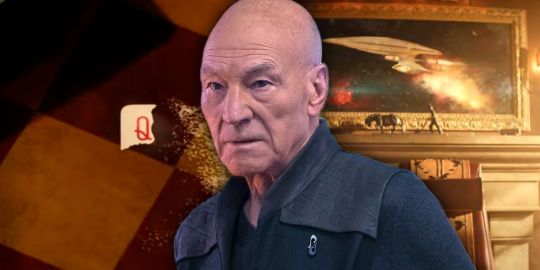
The first Star Trek: Picard season 2 trailer is packed full of exciting tidbits, including a huge reveal about the return of a major character. Star Trek: Picard season 1 premiered in January 2020, showing an aged and retired Admiral Jean-Luc Picard grappling with his own mortality, his rocky relationship with Starfleet, and his ongoing grief over the death of Data. Over the course of season 1, Picard was pulled into an adventure that included banned androids, ex-Borg, and a secret Romulan organization intent on wiping out all synthetic life in the universe.
Picard season 2 has been highly anticipated by fans and as part of StarTrek.com's First Contact Day celebration, a special teaser has been released to give everyone a first taste of what will be in the new season. The trailer features a voiceover by Jean-Luc Picard himself, played by actor Patrick Stewart, and is set to a remixed version of the show's theme. The main point of the voiceover is time: Picard discusses how unforgiving time can be, how it can create regrets, and offer no second chances, while the trailer offers tantalizing shots full of references to previous Star Trek shows.
Related: Star Trek: How Picard Ties In With Kelvin Timeline
Each shot of the trailer has hints about the new season, from small potential Easter Eggs to some huge story reveals. The biggest surprise by far comes at the end when it is revealed that Q, John de Lancie's iconic trickster character from Star Trek: The Next Generation, will be making a return as part of the cast in Star Trek: Picard season 2. In total, there are 12 major reveals that the trailer gives about the new season, enough to give fans plenty to talk about before season 2 premieres.
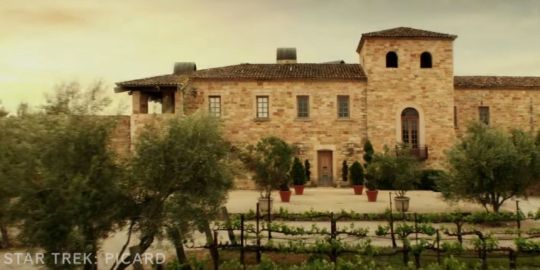
Picard's vineyard features heavily in the season 2 trailer, with the very first shot a slow zoom in on the house and grounds. Château Picard was first seen in Star Trek: The Next Generation in the episode "Family", and returned in Star Trek: Picard season 1 as Picard's new home after retirement. During season 1, Picard shared the vineyard with his dog, Number One, and two Romulan assistants, former Tal-Shiar agents Laris and Zhaban. While the vineyard only featured as a location in the first two episodes of season 1, its return in the new trailer suggests that fans will get a lot more scenes there in season 2. Hopefully, this also means the return of Laris, Zhaban, and Number One as well.

The first line of Picard's voiceover during the trailer states that "The true final frontier is time." There are several levels of significance to this statement, starting with it being a reimaging of Star Trek's iconic phrase "Space: the final frontier." This phrase was part of the voiceover heard during the opening credits of both Star Trek: The Original Series and Star Trek: The Next Generation, but by replacing "space" with "time", Picard almost seems to be challenging one of Star Trek's most well-known doctrines. Additionally, the fact that the trailer's voiceover deals so heavily with time indicates that Star Trek: Picard season 2 will deal with time travel, an important science fiction concept and something that the Star Trek franchise has explored before to great effect.
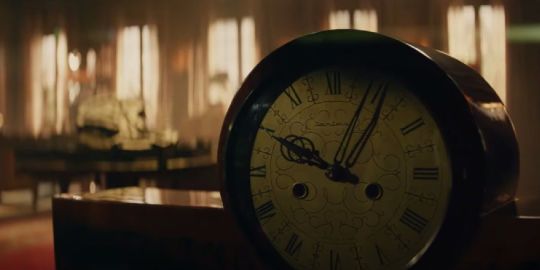
After seeing the outside of the vineyard, the next shot show's the inside of Picard's home office, focusing on an antique clock as Picard discusses how time can turn even the most impulsive actions of an individual into history. The link between the theme of time and the clock is obvious, and having it as the first thing viewers see in Picard's office only serves to drive home the point. It is possible that the time on the clock display could have some significance as well. The display reads 10:05, and although no connection to Star Trek: Picard or the wider Star Trek universe is immediately evident, it is certainly something for fans to speculate about.
Related: Star Trek: How Time Travel Works In Each TV Show & Movie
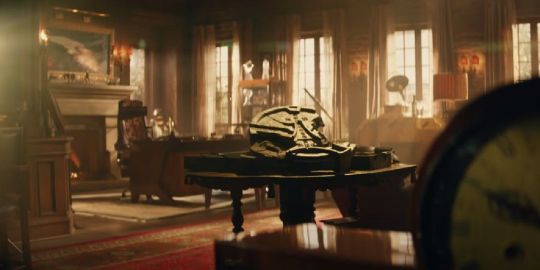
The shot of the clock also includes a brief but surprising look at the Reckoning Tablet, which is sitting on a table behind the clock in Picard's office. The Reckoning Tablet is an ancient Bajoran artifact that was first introduced in the Star Trek: Deep Space Nine episode of the same name. In the episode, the Tablet is discovered in an ancient Bajoran city, and while attempting to decipher the symbols on its surface, Captain Sisko accidentally breaks the tablet and releases a trapped Bajoran prophet and Pah-Wraith, inciting a war between the Prophets and the Pah-Wraiths as a result. The implications of the Reckoning Tablet in the trailer could be numerous, but above all, it suggests a return in Picard to storylines about both the Bajorans and the Dominion War, which was the central storyline for much of Deep Space Nine's seven seasons.

The next big shot of the Picard season 2 trailer is a few shots of a large painting of the USS Enterprise-D hanging on the wall. The final shot of the painting coincides almost directly with Picard saying the word "history", making it clear that Picard's history as Captain of the Enterprise-D is going to be even more important in season 2 than it was in season 1. Featuring the Enterprise-D so heavily in the trailer also could suggest that fans can expect more callbacks to Star Trek: The Next Generation and along with the return of Q, more cameos of beloved TNG characters.
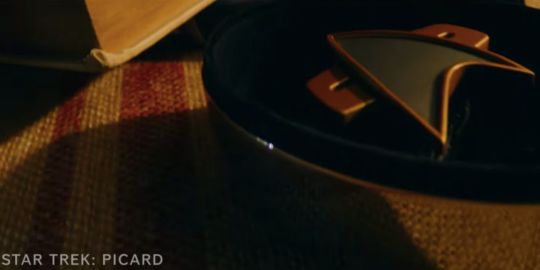
After the painting, viewers are treated to a shot of Picard's old com badge from his Enterprise-D days, sitting in a case on his desk as the camera pans over it. The com badge is immediately identifiable as the classic com badge design from the TNG era, as opposed to the newer, sleeker models that were shown in Picard season 1. The fact that Picard displays the com badge so prominently on his desk seems to show just how important his time as Captain of the Enterprise-D was to him.

The next shot shows an antique edition of Paradise Lost by John Milton sitting on the desk near to com badge. On the surface, this is a reference to Jean-Luc Picard's fondness for antiques, but it is also possible that Paradise Lost itself holds some significance. The work is an epic poem composed in the 17th century that deals with the Biblical stories depicting the Fall of Man, including the temptation of Adam and Eve and Lucifer's fall from Heaven. Star Trek rarely deals with religion directly, but the idea of man's downfall could definitely be connected to Q's return and his assertion from "Encounter at Farpoint" that humans are still a "savage, child race". Additionally, Star Trek: Deep Space Nine had an episode entitled "Paradise Lost" which dealt with Captain Sisko uncovering a plot to seize power from Starfleet and the Federation by a Starfleet Admiral. If the book is a reference to this, it suggests a dark plotline for the new season.
Related: Picard Season 2 Theory: Where Star Trek's Other Borg Are

Picard has a model of the USS Stargazer on his desk, the ship that was his first command before the Enterprise-D. Picard commanded the Stargazer for about 10 years and served on it for a number of years before that. The Stargazer's inclusion in the trailer further perpetuates the idea that Picard's past is going to be significant in the upcoming season, coupled with the references to the Enterprise-D and his voiceover about time. It is even possible that fans will get to learn more about Picard's command on the Stargazer, a period of time that has been reference before but never fully explored.
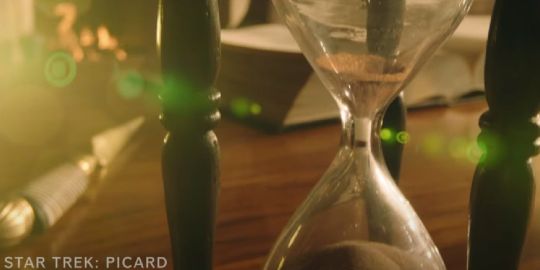
One of the most intriguing shots of the Picard season 2 trailer is a shot of an hourglass that appears to be going in reverse, with the sand trickling upward into the top bulb rather than down. When taken in the context of the entire trailer, especially the previous shots referencing important things from Picard's past, this shot all but confirms the idea that time travel will be a major storyline in Star Trek: Picard season 2. An hourglass in reverse suggests that the flow of time is being reversed, which would mean a return to the past that is likely going to be facilitated by Q. The concept of Q reversing, taking Picard back to his past to re-live his actions and mistakes was explored in the episode "Tapestry" from TNG, so it is very possible it could make a comeback in Picard.

One of the final shots of the trailer is an antique chessboard with two chairs and a stack of playing cards on it set up in Picard's office. Chess has always been a big part of the Star Trek franchise, although the traditional Star Trek chessboard was a more futuristic three-dimensional version. Along with the playing cards, which end up being the way the trailer reveals Q's return, the chessboard could be an indirect reference to Q as well, since in a recent Star Trek: Lower Decks episode Q made the crew of the USS Cerritos into chess pieces.
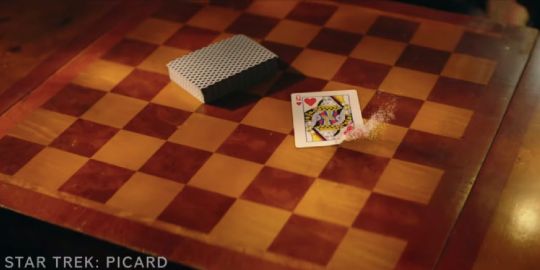
The last shot of the Picard season 2 trailer focuses on the deck of playing cards - in particular, the lone queen of hearts card sitting apart from the rest. The singling out of this card is a reference to the first episode of Star Trek: Picard season 1. In the first scene, during a dream sequence, Picard and Data play poker together, and when Data shows his hand all his cards are the queen of hearts. Although it seemed that Data's story had ended in the season 1 finale, this inclusion in the trailer could mean that more references to Data will be made during season 2.
Related: Star Trek: Data's Death In Picard Failed Geordi La Forge
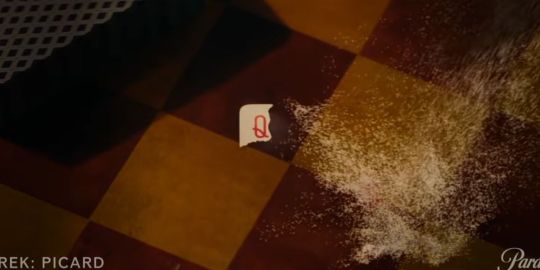
As the camera focuses on the queen of hearts card, the rest of the card dissolves away, until only the "Q" in the corner remains. The voiceover then switches to actor John de Lancie's voice, revealing that Q will be back for season 2 of Star Trek: Picard. Q is one of Star Trek's most iconic characters, and although he has made other appearances throughout the franchise, his return in Picard is especially exciting since Q and Picard's rivalry became hugely popular on Star Trek: The Next Generation. The chance to see it revived is a thrilling one for fans.
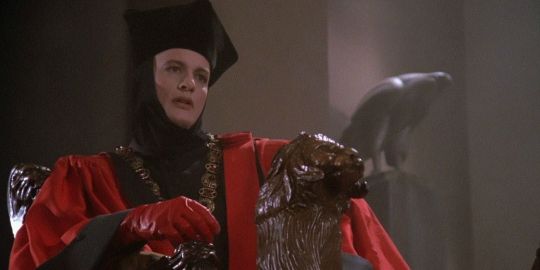
Q's voiceover consists of only one line: "The trial never ends." While the line is brief, its significance should be immediately aware to fans. The line is a direct callback to the same line in the series finale of TNG, "All Good Things...", where Q tells Picard that although he has been convinced that humanity can evolve, he will still be watching and judging their progress. The repeating of this line in the new trailer for Star Trek: Picard suggests that Q is back to his old tricks, and will likely find some significant ways to meddle with Picard and humanity in general in the new season.
Everything in the new trailer, from all the references to past Star Trek shows to the reveal about Q, suggests an extremely exciting new season for Star Trek: Picard. Along with the trailer, the main cast from season 1 has been confirmed to appear in season 2, and the announcement about Q hopefully won't be the last in exciting casting news. For now, fans will have a lot of talk about with all the Easter eggs, theories, and questions that the trailer has provided to ponder.
More: Star Trek: All 4 Shows Captain Picard Appears In, Explained
Star Trek Picard Season 2 Trailer Breakdown: 12 Story Reveals from https://ift.tt/3dAwdtv
0 notes
Text
New from Every Movie Has a Lesson by Don Shanahan: MOVIE REVIEW: Lady and the Tramp
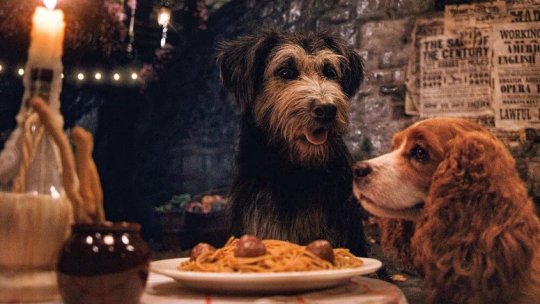
(Image: omeroyaar.com)
For warped reasons of splashy attention and an internal need to top themselves, the overfilled four-film 2019 slate of Disney re-imaginings have favored the gaudy, garish, and just plain loud. Granted, flashy noise appears to makes money, but it does not say much for the true quality of the picture. With unending charm and quaint simplicity, Disney+’s delightful Lady and the Tramp remake proves the old adage of “less is more.” All year long, its mainstream blockbuster peers tried every costly artificial and technological height to be a blaring chorus of bells and whistles, when all that was really needed were some cute, real animals backed often by a swanky band.
This new film is a wise and modest update to one of Disney’s best romances of its Silver Age. By utilizing actual dogs, many of which are rescued pets at that, with a mild computerized varnish, feels more tangible than fake in one of these Disney re-imaginings for the first time in a long time. This restraint of creative prudence is what defines its humble disposition and winning achievements.
Coming to life from the overhead illustrations of Dean Tschetter, Lady and the Tramp descends upon a stunning Victorian home on Christmas morning in the early 20th century. The young newlywed Jim Dear (Me, Earl and the Dying Girl’s Thomas Mann) gifts his wife Darling (Kiersey Clemons of Hearts Beat Loud) a cocker spaniel puppy. Given the name Lady and voiced by Tessa Thompson, the prized pet, through her bedspace takeovers, endears herself as a member of the family, one that is growing by a human bundle of joy at the same time Lady earns her official collar and tag.
LESSON #1: BABY MOVES IN, DOG MOVES OUT — In what should be a trauma listed right there with Stockholm Syndrome, a new baby will almost always absorb adult time and previously undivided attention away from four-legged best friends, even an easy-to-love one like Lady. Like its animated predecessor, this Lady and the Tramp keeps its roots in the imagined psychology and personification of what this might be like from the animal’s perspective.
When a dog-sitting misunderstanding with Aunt Sarah (Community favorite Yvette Nicole Brown) leads to a muzzle purchase and a runaway escape, Lady meets the slick, free-spirited loner Schnauzer, voiced by Justin Theroux, who would come to favor Tramp above his other temporary names around town. He teaches the well-groomed neophyte the owner-less life on the streets avoiding the persistent local dog catcher (Adrian Martinez of Focus). Scrapes lead to scraps and noodles turn into canoodled kinship as the two become close.
LESSON #2: THE PLIGHT OF THE HOMELESS — Family films, animated or otherwise, do enjoy their moments of addressing a societal problem in an approachable fashion. Lady and the Tramp then and now, with its riches-to-rags and rags-to-riches reversals, puts storytelling to the difference between being self-reliant and truly alone without the value of loving relationships. In a way, pets have that two with the shelter and adoption processes. Seeing this cuddly classic story play out with real animals better set off a spike in pet adoptions across the country.
LESSON #3: THE AUDIBLE VOLUME OF BRAVERY, CONFIDENCE, LOYALTY — The manifested personal improvement steps of Lady and the Tramp involve audibilizing in different ways. Lady has never asserted herself with a howl while the brash Tramp has never vocalized his broken feelings. She hasn’t found courage and he hasn’t learned to trust others again. Both help each other with those utterances which bring them together and crack Lesson #2. After all just as Darling extols “we’re not a family without you.”
Thanks to its period-era setting and the lively ragtime jazz of its Savannah, Georgia locale, there is a jazzy flair to everything. That pep gives a new pace to the barky banter shared between Theroux and Thompson. The supporting voice cast, led by the dual-threat Janelle Monae, a saucy Benedict Wong, Scotswoman Ashley Jensen, and gristle of Sam Elliott, are excellent and distinctive additions. Strolling and walking on two feet instead of four, even the human actors add little eccentricities to match the light style without anyone being over-the-top whatsoever. By the time Arturo Castro and F. Murray Abraham serenade their “Bella Notte,” you’re in heaven right there with the love-struck pooches.
In every major and minute production detail, tangible textures and patiently composed feels imbue the dainty enchantment of the movie, and they come from very unexpected sources. One would think the director of The LEGO Ninjago Movie would make something wildly feverish. At the same time, one might also expect the very adult mumblecore filmmaker responsible for Funny Ha Ha and Support the Girls to never involved himself in a Disney romance with dogs. Additionally, Yet, here are director Charlie Bean and lead writer Andrew Bujalski (with a boost from newcomer Kari Granlund) disarming us all with their own sprinkles of magic. The unexpected artistic transitions did not end there.
Legendary costume designer and four-time Academy Award winner Colleen Atwood graced this film with her period-era presence in a spot where the lead characters are never adorned with threaded finery. John Myhre, the two-time Oscar-winning production designer behind the stage numbers of Chicago, Nine, and Memoirs of a Geisha, created grand sweep within the sumptuous architectural antiquities of Savannah. 28 Days Later and Bumblebee cinematographer Enrique Chediak traded chasing zombies and robots with handheld cameras for the stable dollies following the darting dogs under legs and wheels on cobblestone streets. The live-action velocity of this Lady and the Tramp required marvelous training from lead animal coordinator Mark Forbes and a fair bit of stunts for San Andreas coordinator Bob Brown.
Even Tron: Legacy and Only the Brave electronic music veteran Joseph Trapenese finds himself channeling his The Greatest Showman side with pleasant orchestrations that evoke and retain much of the original Sonny Burke and Peggy Lee music from 64 years ago. Co-star Janelle Monae is a welcome new voice for Burke and Lee’s lyrics who does not try to overpower what already works as it is.
To have an effortless and bewitching finished film come from this kind of collection of diverse talent working out of their usual elements demonstrates a measured, inspired, and carefully minded level of production. Nothing is over-amplified and the result is more family-friendly than most of the action-ified re-imaginings of the calendar year from the Mouse House. Once again, it is a concerted effort not to do too much or be too big. This confluence cannot be complemented enough. This movie alone is worth your first month of the new subscription streaming service.

LOGO DESIGNED BY MEENTS ILLUSTRATED (#839)
Permalink
from REVIEW BLOG – Every Movie Has a Lesson https://ift.tt/32xh8By via IFTTT
from WordPress https://ift.tt/33DfmQx via IFTTT
0 notes